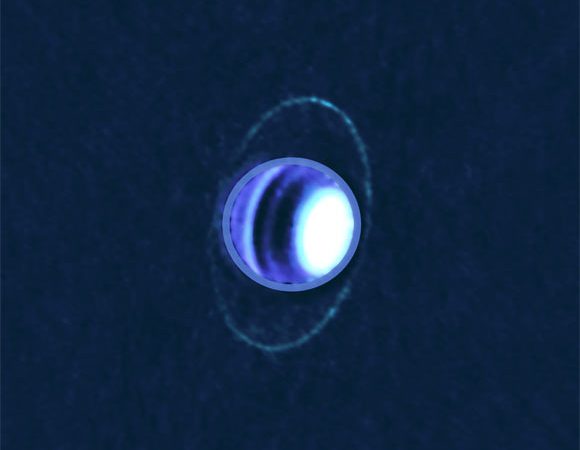The rings of the ice giant Uranus are invisible to all but the largest telescopes — they weren’t even discovered until 1977. However, they are surprisingly bright in the new thermal images taken by the Atacama Large Millimeter/submillimeter Array (ALMA) and ESO’s Very Large Telescope (VLT). The new images allowed astronomers for the first time to measure the temperature of rings particles: minus 321 degrees Fahrenheit (minus 196 degrees Celsius).
Source: Sci News
“New observations confirm that Epsilon, Uranus’ brightest and densest ring, differs from the other known rings within our Solar System, in particular, the spectacularly beautiful rings of Saturn, that are broad, bright and have a range of particle sizes, from micron-sized dust in the innermost D ring to tens of feet in size in the main rings,” said Professor Imke de Pater, from the University of California, Berkeley.
“The small end is missing in the main rings of Uranus; the Epsilon ring is composed of golf ball-sized and larger rocks.”
By comparison, Jupiter’s rings contain mostly small, micron-sized particles (a micron is a thousandth of a millimeter).
Neptune’s rings are also mostly dust, and even Uranus has broadsheets of dust between its narrow main rings.
“We already know that the Epsilon ring is a bit weird because we don’t see the smaller stuff,” said Edward Molter, a graduate student at the University of California, Berkeley.
“Something has been sweeping the smaller stuff out, or it’s all glomming together. We just don’t know. This is a step to further understanding their composition and whether all of the rings came from the same source material or are different for each one.”
Uranian rings could be former asteroids captured by the planet’s gravity, remnants of moons that crashed into one another and shattered, the remains of moons torn apart when they got too close to Uranus, or debris remaining from the formation 4.5 billion years ago.
“The rings of Uranus are compositionally different from Saturn’s main ring, in the sense that in optical and infrared, the albedo, thus the reflectance capacity, is much lower: they are really dark, like charcoal,” Molter said.
“They are also extremely narrow compared to the rings of Saturn. The widest of them, Epsilon, varies from 12 to 62 miles (20-100 km) wide, whereas Saturn’s are hundreds or tens of thousands of miles wide.”
The lack of dust-sized particles in Uranus’ main rings was first noted when NASA’s Voyager 2 spacecraft flew by the ice giant in 1986, however, the probe was unable to measure the temperature of the rings.
To date, astronomers have counted a total of 13 rings around Uranus, with some bands of dust between the rings.
Both the VLT and ALMA observations were designed to explore the temperature structure of Uranus’ atmosphere, with VLT probing shorter wavelengths than ALMA.
“We were astonished to see the rings jump out clearly when we reduced the data for the first time,” said Dr. Leigh Fletcher, from the University of Leicester.
The findings will be published in the Astronomical Journal.

































Leave a Comment
You must be logged in to post a comment.